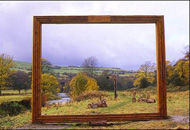Irwell Sculpture Trail
Location: Chatterton, Lancashire, UK
Artist: Richard Caink
Overview
In the Picture is a significant sculpture on a well-usedpublic footpath beside the River Irwell whichresultedfrom a six monthresidency by Richard Caink in nearby Chatterton. It is one of33 commissions arising from similar community based residencieswithin the five year programme of the Irwell Sculpture Trail.The work is a giant wooden picture frame, 4.8m high and 6m wide,which frames a view of an idyllic landscape of woods and fields,with carved wooden sculptures in the foreground. The footpathruns through the frame allowing the visitor to step into the ‘picture’ asboth the viewer and subject of the piece. The work comes alivethrough the participation of the viewer and encourages activeengagement.
The sculpture is an attractive and accessible piece and is already regularly featured in local media and tourism publications, and is the frequent destination of fundraising walks. The sculptures which depict broken cogs, a shattered pulley, a sledge hammer and a symbolic indication of the ever-present river, refer to the industrial history of the valley and the riots in Chatterton against the introduction of power looms in 1826, during which 3 people were shot. The massive traditional moulded picture frame presents the scene to the viewer, and refers to landscape painting during the 18th and 19th centuries which was often used by the landed gentry as a display of ownership. Here the artist is commenting on the physical access to privately-owned land, and consequent emotional ownership, enjoyed by the public along this public footpath, and resistance by some landowners to the increased public use supported by the Irwell Sculpture Trail project.
Artist Selection
Richard Caink was one of the first artists to undertake a residency and associated commission on the Trail. Residencies in six communities were offered all at one time and clear briefs were prepared. Through advertisements in Artists Newsletter, Artworks and local press, interested artists were invited to submit slides, a Curriculum Vitae and a statement from which a shortlist of five artists for each of the residencies was drawn up by the Officer Working Group for the Irwell Sculpture Trail. The interview panel for these first residencies comprised the whole Officer Working Group. Panels for subsequent residencies have included local councillors and residents.
Initial Support
The artist began his six month residency in the small village of Chatterton, just north of Ramsbottom, in April 1997, at the same time as the other five artists in residence. At this early stage of the Irwell Sculpture Trail, and with no overall Projects Officer for the Trail in post, strategies for supporting the artists in residence were not fully in place. Richard was simply given a list of local contacts in schools, the community and Local Authority, and expected to find his own accommodation and forge his own partnerships. He found it difficult to involve local people and was most successful working through two local schools to reach the wider community. Learning from this, officers of the relevant local councils have given far more initial support to subsequent artists in residence to settle them into their placements and help with establishing community contacts.
Local Involvement
The first few months of the residency were spent talking to local people, organisations and council officers to find out about the valley, its local history and geography. The artist then ran a sequence of workshops for children at the two primary schools serving Chatterton, and carved a bench for the environmental garden in each, and was involved with the village fair and the annual district Rossfest. By mid-way through the six month residency, he had developed a sculpture proposal and with support from the planning department of Rossendale Borough Council, was able to access a supply of wood of the right dimensions.
Permissions
The artist had considerable difficulty in finding out who owned the land where he wanted to site the work, and when he wrote to the landowner, a reply was very slow in coming. Planning permission was also needed for the work which was to be placed across a public footpath. Councillors were concerned that the path should remain completely accessible and permission was granted on condition that the frame was set to one side of the path. Dealing with these issues was a great pressure for the artist who was also trying to complete the work itself on time.
Installation
Working at his open air studio which he set up on the playing field near the eventual site, Richard Caink was able to talk to residents informally as they passed by and they could see the work as it progressed, helping to draw them into the project. In the Picture was installed on site with the help of a tractor, and was unveiled in November 1997 in the presence of all who had been involved, with a walk to the site followed by food and drink at the Groundwork Trust base in Rawtenstall, via a ride on the East Lancashire Railway. The piece was designed to last at least five years and the artist has provided Rossendale Borough Council with an annual maintenance schedule as part of his contractual brief.
© Copyright Joanna Morland 2000

